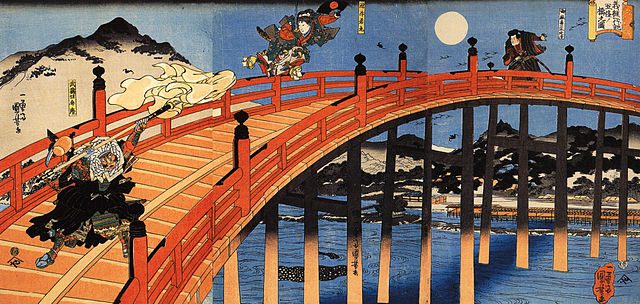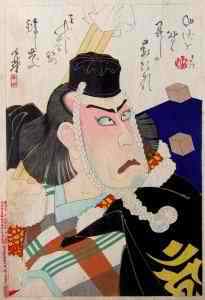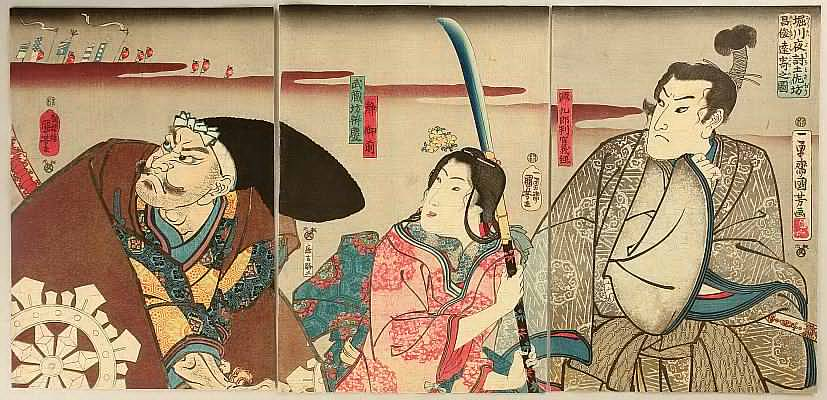Art of Japan and holy Buddhist warrior of the twelfth century
Lee Jay Walker
Modern Tokyo Times

The Buddhist warrior Saito no Musashibo Benkei (1155-1189) is revered in Japan concerning people who adore culture, history, and various angles of Japanese folklore. His loyalty to Minamoto no Yoshitsune was complete and steadfast at all times. Therefore, the highly esteemed Benkei remains in the public imagination in modern Japan despite the passage of time.
His heroic military prowess was magnified in art, culture, folklore, history, kabuki, and literature. Benkei is also represented in anime and other modern mediums. Hence, the artistic world of ukiyo-e during the Edo Period utilized his heroic military background.

The Toshidama Gallery says, “Benkei was born in 1155 and reputedly of enormous strength and vitality; he was raised by monks who were both religious and military. As a young man he positioned himself at one end of Gojo Bridge and disarmed travellers of their swords. On reaching his 999th sword he fought with a young nobleman, Minamoto no Yoshitsune, who won the battle of the bridge and thereafter Benkei served as his principal retainer. They fought in the Gempei Wars between the Taira clan and their own Minamoto clan.”
Benkei turned to the mysteries of the Yamabushi (the mountain warrior monks) according to Japanese folklore. This isn’t surprising given his military prowess and the impact of Buddhism on his inner soul. Equally important, the Yamabushi were famous for amazing qualities based on religious knowledge, living with nature, enduring severe hardship, and other noble areas.

The asceticism of the Shugendo doctrine of esoteric Buddhism – concerning the richness of Shingon Buddhism – fused many ideas, faiths, and philosophies that benefitted warriors like Benkei. Hence, for Benkei – and other warrior monks – the Buddhist sects of Shingon and Tendai – along with aspects of Shintoism and Taoism – enabled these warriors to reach a different plain outside the scope of traditional warriors. Therefore, the natural physical strength of Benkei, who was believed to be at least two meters tall, was matched by his religious conviction and Benkei’s abiding loyalty to Yoshitsune until the very end.
Benkei belonged to a warrior class that is difficult to imagine in the modern world. Thus, the impact of esoteric Buddhism and mystical fusions of Shintoism and Taoism – within the mysteries of the mountain warrior monks – elevated his fighting prowess and numbed his brain from the fear of death.
http://www.toshidama-japanese-prints.com/item_237/Kunisada-Portrait-of-Benkei.htm
http://www.toshidama-japanese-prints.com/item_246/Yoshitaki-Benkei-and-Yoshitsune-at-Gojo-Bridge.htm

PLEASE SUPPORT MODERN TOKYO TIMES by DONATING
Modern Tokyo News is part of the Modern Tokyo Times group
DONATIONS to SUPPORT MODERN TOKYO TIMES – please pay PayPal and DONATE to sawakoart@gmail.com
http://moderntokyotimes.com Modern Tokyo Times – International News and Japan News
http://sawakoart.com – Sawako Utsumi personal website and Modern Tokyo Times artist
https://moderntokyonews.com Modern Tokyo News – Tokyo News and International News
PLEASE JOIN ON TWITTER
https://twitter.com/MTT_News Modern Tokyo Times